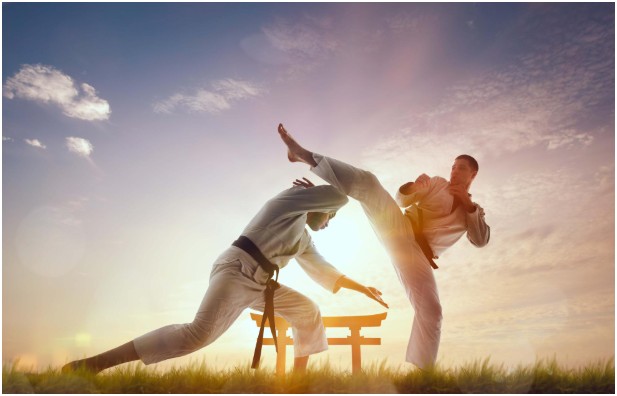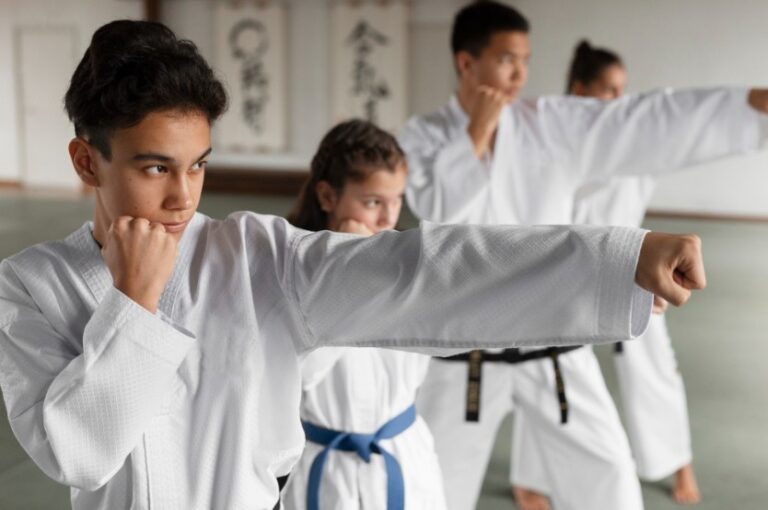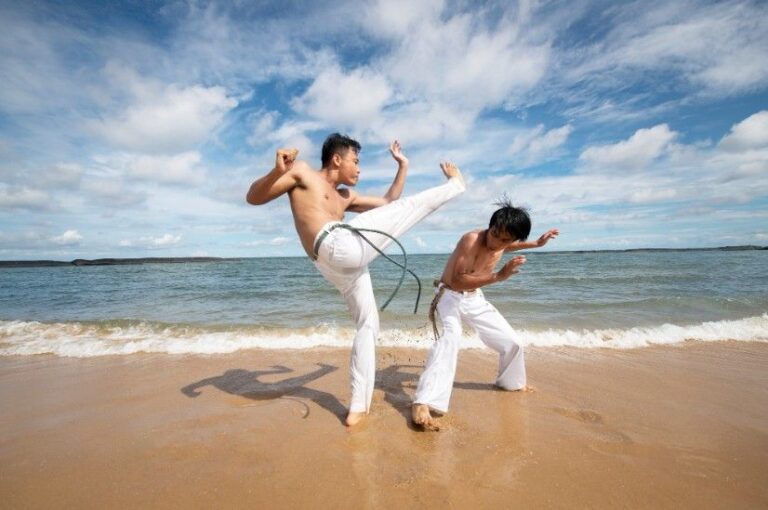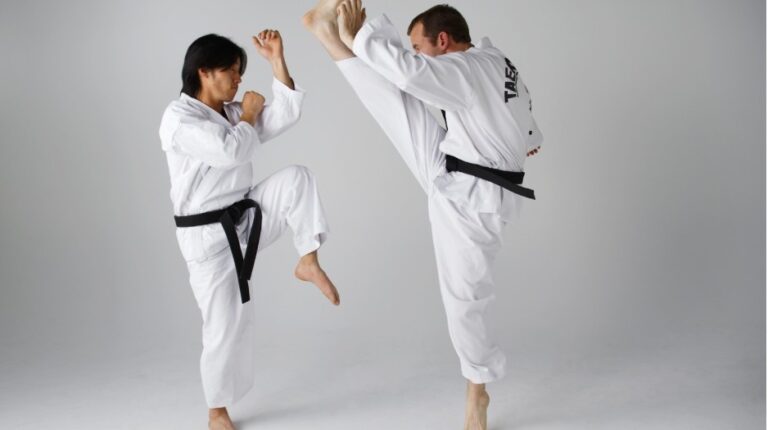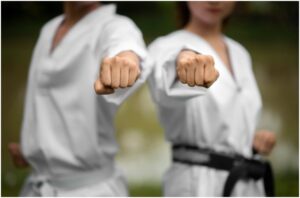So you’ve finally decided to unleash your inner ninja—great! But now you’re facing the ultimate martial arts showdown: karate vs taekwondo, which is better?
Top difference after top difference seems to pop up on every blog. One’s all about fancy footwork, the other brings the punchy precision. Which one do you choose?
Let’s dive into the dynamic world of martial arts and break down this epic battle of East Asian excellence. Bonus? You’ll be fluent in the lingo of dojos and dojangs by the end. Let’s go!
The Origins Story: Karate and Taekwondo Go Way Back
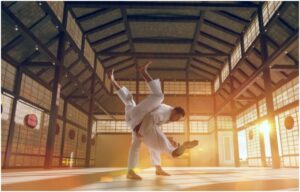
Let’s start with a little martial arts history lesson—minus the boring parts.
Karate: Made in Okinawa, Perfected in Japan
Karate was born in the Ryukyu Kingdom (modern-day Okinawa) and heavily influenced by Chinese martial arts. It found a home in mainland Japan in the early 20th century. Its name means “empty hand,” symbolizing its focus on strikes without weapons.
Taekwondo: Korea’s Kicky Crown Jewel
Taekwondo (태권도) came to life in Korea post-WWII, combining traditional Korean combat arts like Taekkyeon and Hwa Rang Do with some karate influence. It’s now South Korea’s national sport and an Olympic martial art. Talk about glow-up!
Karate vs Taekwondo, Which Is Better? Top Difference Breakdown

It’s comparison time—grab your belt, because we’re about to spar with facts.
1. Focus of Technique
- Karate: Punches, hand strikes, and linear movements dominate. Kicks are there, but the hands do the heavy lifting.
- Taekwondo: Welcome to kick city! Jumping, spinning, and head-height kicks are the stars of the show.
Winner: Depends on your limbs of choice. Fancy feet? Go Taekwondo. Precision hands? Karate’s your jam.
2. Stance and Movement
- Karate: Low, grounded stances. Think stability and strong bases.
- Taekwondo: Upright, bouncing stances built for explosive kicks.
Top Difference: Karate is about firm foundations; Taekwondo is fluid and fast-paced.
3. Sport vs Self-Defense
- Karate: More traditional in self-defense focus.
- Taekwondo: Leans heavily into sport competition, especially with Olympic status.
Karate vs Taekwondo, which is better? Top difference here is about intention—self-defense vs sport. Both do both, but each has a clear specialty.
4. Scoring in Competitions
- Karate: Points for clean hits with strong form. Punches to the body and head are legit.
- Taekwondo: High kicks, spinning kicks, and headshots = big points. Less emphasis on hand strikes.
If you love high-flying kicks and acrobatics, Taekwondo might be your MVP.
5. Forms (aka Poomsae vs Kata)
- Karate: Kata—precise, grounded patterns.
- Taekwondo: Poomsae—fluid, kick-focused forms.
The top difference lies in the rhythm and philosophy: Karate’s kata is sharp and deliberate; Taekwondo’s poomsae is dynamic and graceful.
Is Taekwondo Better Than Karate?

Ah, the million-dollar question: Is Taekwondo better than Karate? Well, it’s like asking if tacos are better than burgers—it depends on your taste!
If you love high-flying kicks, fast footwork, and Olympic aspirations, Taekwondo might win your heart (and your hamstrings). But if you’re all about powerful punches, grounded stances, and traditional self-defense, Karate could be your martial match.
Bottom Line? Neither is universally “better”—just better for you. Try both, see what sparks joy, and break boards accordingly!
Which Is Better for Kids?

Both are amazing for children, promoting discipline, respect, and physical fitness. But here’s the real scoop:
- Karate: Great for kids who love structure and strong foundations.
- Taekwondo: Ideal for energetic kiddos who love movement and dynamic kicks.
Pro Tip: Most U.S. schools offer trial classes—let your kid test both!
Which One Builds More Fitness?
- Taekwondo tends to build more lower-body strength and cardio due to its kick-heavy approach.
- Karate develops upper-body strength and core stability through repetitive striking and stances.
Fitness Freak Verdict: Why not do both? Or start with one and cross-train later!
Philosophy and Culture
- Karate: Rooted in Japanese culture—bowing, discipline, and the Bushido code.
- Taekwondo: Deeply tied to Korean values—courtesy, integrity, perseverance, self-control, and indomitable spirit.
Both martial arts emphasize respect, humility, and personal growth.
Belt Systems
Both use a color belt system (white to black), though the order and criteria vary slightly. Higher ranks require demonstration of technique, knowledge, and attitude.
Karate vs Taekwondo, Which Is Better for You?
This is where you ask yourself:
- Do I love flashy kicks? → Taekwondo
- Do I prefer close-range strikes and balance? → Karate
- Do I want to compete in the Olympics someday? → Taekwondo
- Do I want practical, traditional self-defense? → Karate
The answer to “karate vs taekwondo, which is better? Top difference” often depends on your personality, goals, and preferred style of movement.
Karate vs Taekwondo—The Ultimate Black Belt Breakdown
Let’s be honest—there’s no one-size-fits-all champion in the karate vs taekwondo, which is better? top difference debate. Both are powerful, beautiful, and deeply respected martial arts. Your best pick is the one that makes you excited to show up, work hard, and grow.
Whether you end up mastering Taekwondo’s tornado kicks or Karate’s crushing punches, you’ll gain discipline, confidence, and one killer set of skills.
So, lace up that gi or dobok, tie your belt tight, and step onto the mat—the only real loser is the person who never starts.





